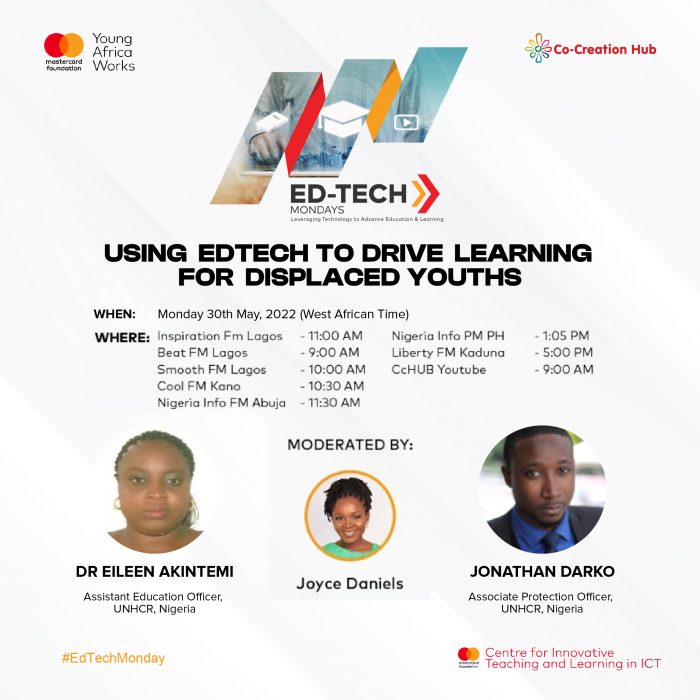As countries worldwide grapple with the increase in the number of refugees and displaced persons, one important challenge associated with this displacement is that refugee students are struggling to catch up with their education. Even when they have access to continue their education, the learning conditions are often limited. Studies have shown that as of 2020, the total number of refugees and IDP children in North-Eastern Nigeria from ages 3 to 17 years is 452,620. Of this population, 63% attend primary school, while 67% of adolescents 14 to 17 years do not have access to secondary education.
Heightened by the lockdown in 2020, technology has proven to be a great enabler of learning especially in the midst of a crisis with opportunities for remote and self-paced learning. In preparation for World Refugee Day in June, the EdTech Monday Show for the month of May focused on exploring ways in which EdTech can be leveraged to drive learning and reduce learning poverty for displaced youths in Nigeria.

We had the pleasure of hosting a team from the office of the United Nations High Commissioner for Refugees (UNHCR) and refugee youths who were the discussion feature at the May episode of EdTech Monday. The show is a platform to facilitate critical conversations on the use of technology to enhance teaching and learning. During the discussion, the panelists reflected on learnings from their engagement with refugee communities and the different ways education technology can be leveraged to drive learning for displaced youths.
Here are some excerpts from the conversation;
How will you rate the level of access to technology at the camps, and do students or the schools use any educational technology products?
“A challenge that refugees have faced is the immense disruption to their learning. In my area of operation specific to Cameroonian refugees, displaced people do not live in camps but in settlements, attending the same schools as youths in the host communities. Technology has proven to be a great enabler of quality education, especially in terms of access, providing refugees with the opportunity to continue learning even in situations where they cannot be physically present in the classroom. Through distance learning programmes amongst other platforms, education technology complements the traditional learning experiences of refugees and displaced youths.” – Jonathan Darko (Associate Protection Officer, UNHCR Nigeria)
How should the diversity within refugees and IDP camps inform the development of educational intervention programmes and products?
“It is one thing to build learning products and programmes for displaced youths, and it’s an entirely different thing for the target audience to find the solutions relevant, and useful and actually get to use them. In the refugee settlements, we have people from various cultures speaking various languages and these students attend schools within the same community. When building learning products or designing learning programmes, innovators should take into consideration the language and learning cultures of the immediate environment. This will help to ensure that education solutions are contextually relevant and accommodate the various discrepancies that exist among refugees and displaced youths.” – Dr Eileen Akintemi (Assistant Education Officer, UNHCR Nigeria)
What does it mean for the potential of EdTech products to scale and reach displaced people globally?
“Displaced youths are very interested in taking advantage of distance learning opportunities, but the lack of infrastructure and resources is something that holds them back. This speaks more to the need for increased opportunities for refugees in tertiary institutions with options for remote or distance learning as well as access to internet connectivity. Beyond seeing these as humanitarian interventions, it is more about development initiatives since refugees in Nigeria do not live in isolation but amongst other Nigerians.” – Jonathan Darko
In what ways do you think access to Technology Devices will impact learning for displaced youths?
“Access to education through technology will be a life-changing opportunity for refugees, offering us a lot of new experiences and information.” – Sandra Tiwa
“Beyond promoting continuing education platforms for displaced youths, access to EdTech also helps adults who were gainfully employed before the crisis to learn new things and get empowered to move forward.” – Elias Tako
How can we build education systems, programmes and products that consider the fact that not all learners travel through education in a linear way?
“With technology, alternative learning programmes and catchup classes can be designed into curriculums and delivered to refugees in the form of mobile applications to endure that displaced youths are not left behind.” – Dr Eileen Akintemi
What do governments, Edtech companies, and innovation funders need to understand about delivering learning in contexts of displacement?
“Refugee education is the vehicle through which displaced youths realise their dreams. The government is in the driving seat to ensure that refugees are able to participate in national systems. Thankfully, in Nigeria, we have an out of camp policy which allows refugees to live wherever they choose to. It is important that donor and development organisations join forces with the government to provide adequate learning infrastructure and resources to host communities where refugees live.” – Jonathan Darko
One thing that stood out from the engagement is the out-of-camp policy of the Nigerian government regarding refugees which makes it easier for them to get integrated into the national system. However, it is important to note that the influx of refugees to any host community increases the pressure on the available schools and learning resources hence reducing the quality of delivery of teaching and the learning outcomes of learners.
Having explored the possibilities of education technology in driving learning for displaced youths and the obvious challenges to promoting the use of EdTech, it is important that we push for the government to repurpose the funding that should be used to develop isolated refugee camps into developing the existing infrastructure and resources in the host communities to accommodate the addition of refugees. In addition, development agencies and EdTech organisations should consider leveraging the diversity amongst refugees and displaced youths when designing intervention programmes and products.

